The Union Jack is among the world’s most recognizable symbols. Throughout history and into the present day, it has been used in dozens of different flag designs. These indicate a past or current relationship with the British Empire, where the Union Jack design originally came from. Although the era of global colonialism by the British Empire has passed, the Union Jack is a remaining symbol of the relationship that many countries and territories once had or still have with the United Kingdom. In fact, dozens of countries, territories, and states or provinces still incorporate the Union Jack into the designs of their flags. Let’s take a look at the Union Jack and learn about some of the countries that use the Union Jack in their flags today.
Overview of Countries that Use the Union Jack in Their Flags
Today, there are five countries in the British Commonwealth that include the Union Jack as part of their country’s flag. The Commonwealth is also known as the “British Commonwealth of Nations” or simply the “Commonwealth of Nations.” It is an association of sovereign states that comprise the United Kingdom and several other states that still have close ties to the United Kingdom, despite gaining independence from the United Kingdom’s oversight. These nations still keep the British monarch as the head of the Commonwealth. The only Commonwealth territory that does not have the Union Jack as part of its flag today is Gibraltar.
Historically, there were other countries that included the Union Jack in their flag, which no longer do today. Canada was the first Commonwealth country to remove the Union Jack from the flag, in 1965, though Canadian provinces still include the Union Jack in their designs. Previously, Canada has the Union Jack in its flag design from 1868 to 1965. Rhodesia (now Zimbabwe) included the Union Jack from 1964 to 1968. South Africa was the most recent Commonwealth country to remove the Union Jack from its flag, after having it in the design from 1928 to 1994. Even the United States, before gaining independence from Britain, had the Union Jack as part of its flag from 1775 to 1777.
Union Flag or Union Jack?

Some believe that the British flag should only be referred to as “Union Jack” when flown aboard a ship.
Image: Rob Atherton, Shutterstock
©Rob Atherton/Shutterstock.com
For years, people have debated when it is appropriate to refer to the “Union Flag” as the “Union Jack.” Some say that the flag should only be called the “Union Jack” when flown aboard a ship. However, this matter was settled in 1902 and confirmed by the British Parliament in 1908. They proclaimed that either may be used, regardless of whether the flag is flown on land or at sea.
Today, 23 countries across the globe still include the Union Jack in their flags. This includes many previous British colonies, current Commonwealth nations, and current British territories. The list below includes overseas territories, provinces, and states that include the Union Jack in their flag design. Let’s go, beginning with the place where the Union Jack first originated: the United Kingdom.
Commonwealth Nations with the Union Jack in Their Flags
United Kingdom, Adopted in 1801
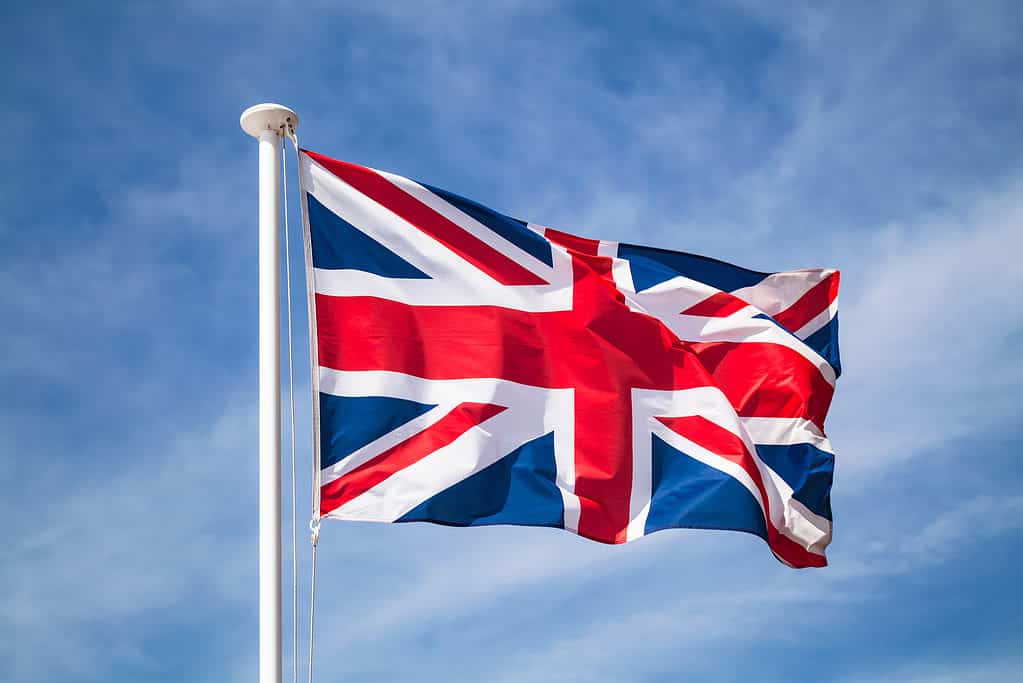
The national flag of the United Kingdom is the Union Jack, also known as the Union Flag, is seen here waving in the wind against a blue sky.
©iStock.com/eugenesergeev
The United Kingdom’s national flag is the Union Jack, also known as the Union Flag. It gained its name for combining the crosses of three countries in the United Kingdom: England and Wales, Scotland, and Ireland. The cross of St. George is a red cross on a white background. After James I succeeded to the throne, it was combined with the cross of St Andrew in 1606. The cross saltire of St. Andrew, patron saint of Scotland, is a diagonal white cross on a blue background. The cross saltire of St. Patrick, patron saint of Ireland, is a diagonal red cross on a white background. The red crosses are edged in white against a dark navy background.
After the Act of Union of Ireland with England, Wales, and Scotland in 1801, the Union Jack was created to show the combined kingdom and has been flown ever since. With that in mind, let’s learn about the other countries whose flags include the Union Jack.
Australia, Adopted in 1908
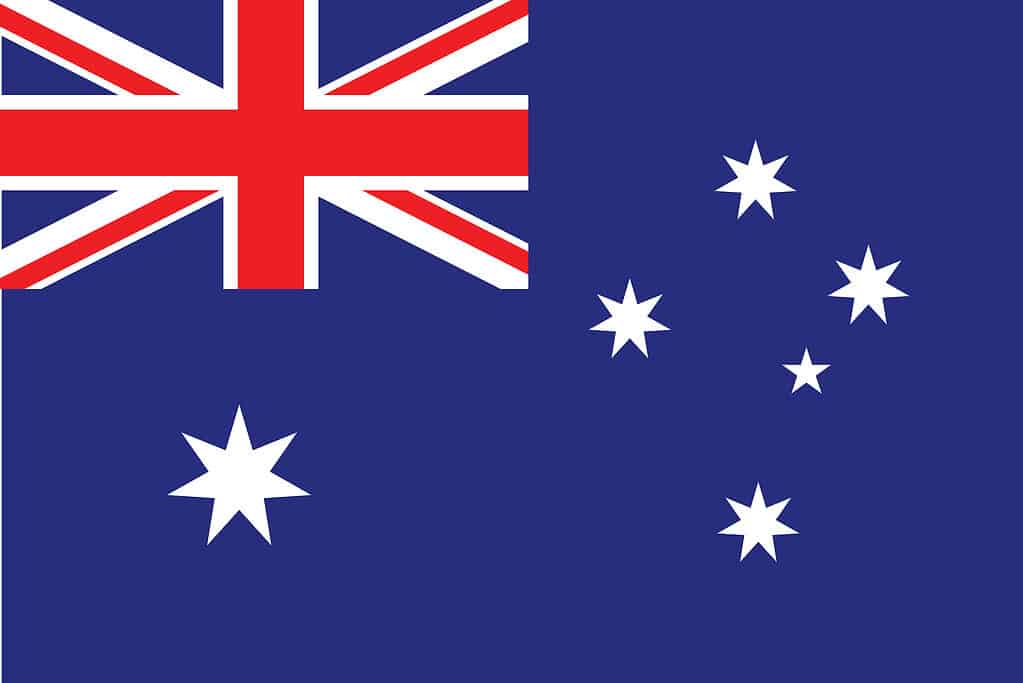
This is the flag of Australia.
©iStock.com/Ardani Saputro
Australia has used its current flag since 1901, though it was modified slightly in 1908. The Union Jack sits above a seven-pointed “commonwealth star” at the side of the Southern Cross, which is a constellation of five stars visible in the southern hemisphere. All of the country’s six states incorporate the Union Jack as well.
- Victoria, Australia, adopted in 1870
- New South Wales, Australia, adopted in 1876
- Queensland, Australia, adopted in 1876
- Tasmania, Australia, adopted in 1876
- South Australia, Australia, adopted in 1904
- Western Australia, Australia, adopted in 1953
Fiji, Adopted in 1970

The flag of Fiji includes the Union Jack.
©MP_Foto/Shutterstock.com
Fiji’s flag includes the Union Jack on a pale blue background to the left of a coat of arms. The Coat of Arms of Fiji was adopted in 1908 and includes a shield with a St. George’s Cross dividing the shield into quarters, with a red band topped by a gold lion. In the top left quarter is three sugar canes, the top right is a coconut palm tree, in the lower left is a dove with an olive branch, and the lower right portion shows a bunch of bananas.
New Zealand, Adopted in 1902
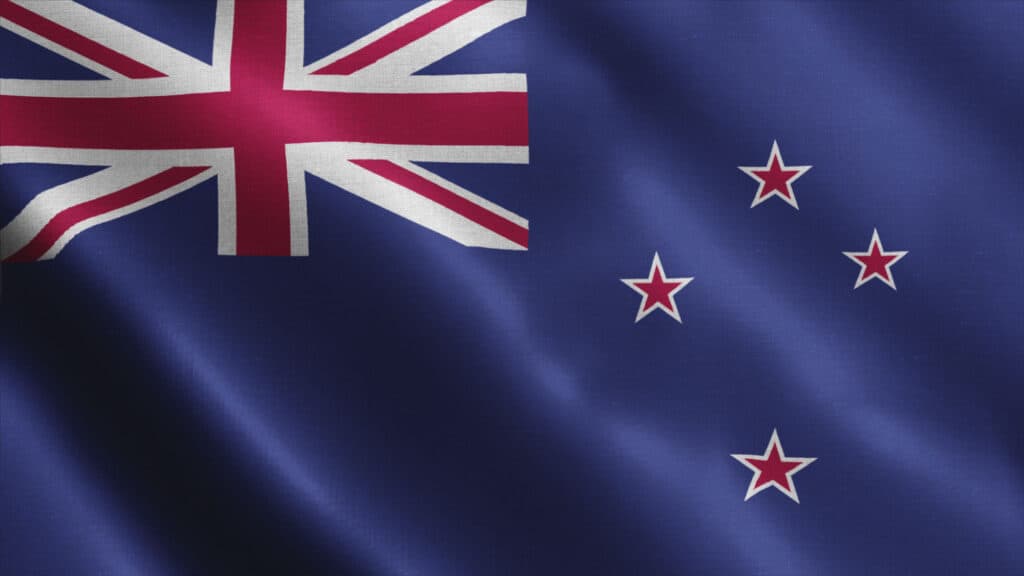
The flag of New Zealand includes the Union Jack and stars of the Southern Cross.
©Tatohra/Shutterstock.com
The New Zealand flag has a royal blue background derived from the ensign of the Blue Squadron of the Royal Navy. The Union Jack in the left-hand top corner acknowledges New Zealand’s history as a British colony. To the right, the stars of the Southern Cross emphasize this country’s location in the South Pacific Ocean.
Tuvalu, Adopted in 1997

The flag of Tuvalu sports the Union Jack on a pale blue background.
©Black Pearl Footage/Shutterstock.com
Tuvalu, which is located in the South Pacific, removed the Union Jack from its official flag in 1996. Only a year later, Tuvalu added the symbol back to the flag. Tuvalu’s flag includes the Union Jack on a pale blue background to the left of nine yellow stars.
Overseas Territories with Union Jacks in Their Flags
Akrotiri and Dhekelia, 1978/1960

Akrotiri and Dhekelia fly the Union Jack.
©iStock.com/titoOnz
The Sovereign Base Areas of Akrotiri and Dhekelia do not have an individual official flag. Instead, the territory flies the Union Jack.
Anguilla, Adopted in 1990

The flag of Anguilla includes the Union Jack and dolphins in the Coat of Arms.
©Greens and Blues/Shutterstock.com
Anguilla’s flag includes the Union Jack in the top-left corner, using the traditional blue ensign, but with a coat of arms on the right. The Coat of Arms of Anguilla is a white seal with three orange dolphins forming a circle above pale blue ocean water. These dolphins stand for friendship, wisdom, and strength.
Ascension Island, Adopted in 2013
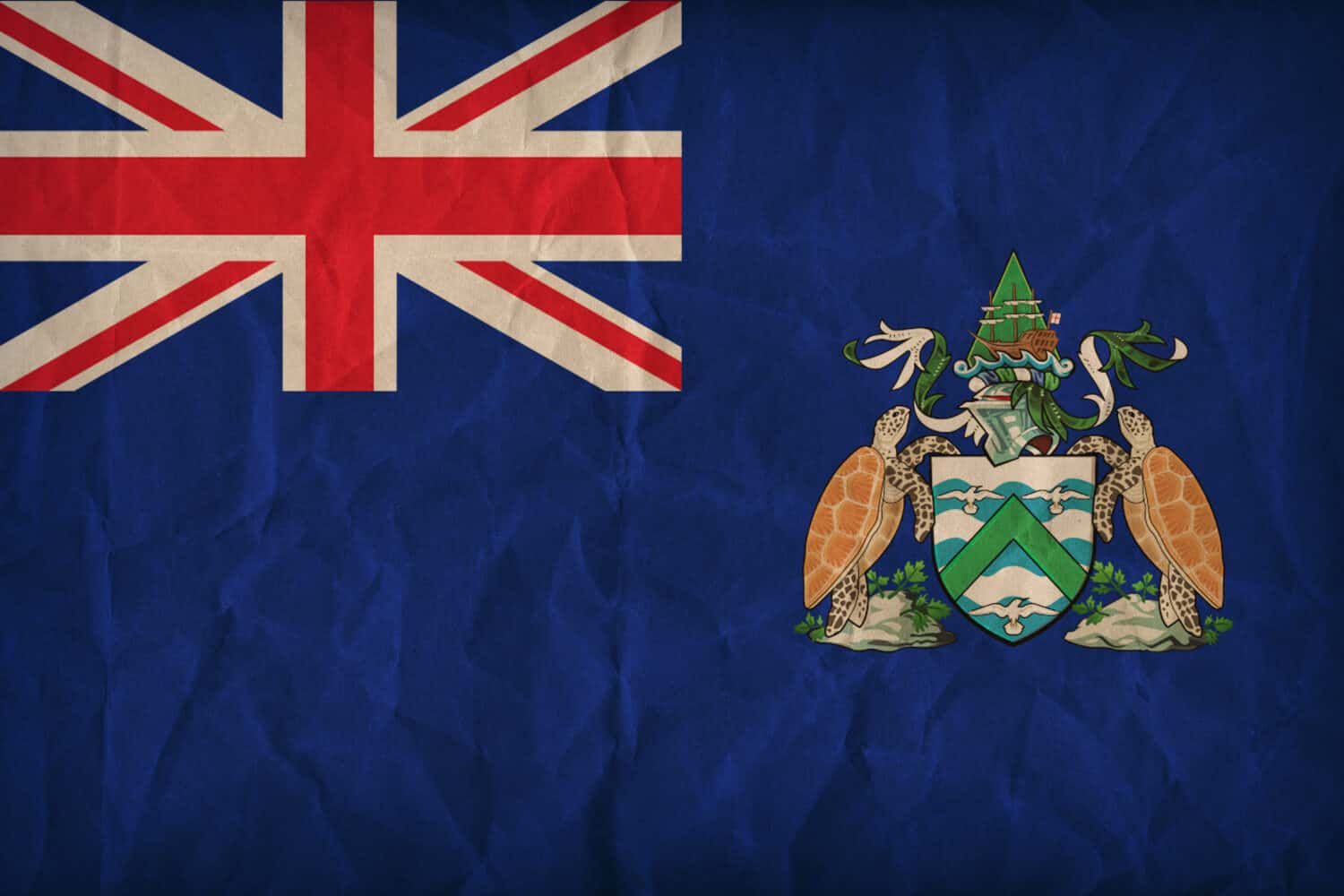
This is the flag of Ascension Island.
©Wasan Ritthawon/Shutterstock.com
Since 2013, Ascension Island has had its own flag. Before, Ascension Island only flew the Union Jack. However, the new design incorporated the Union Jack while adding three other symbols: three birds and two turtles, plus a suit of armor’s helmet topped by a ship.
Bermuda, Adopted in 1910
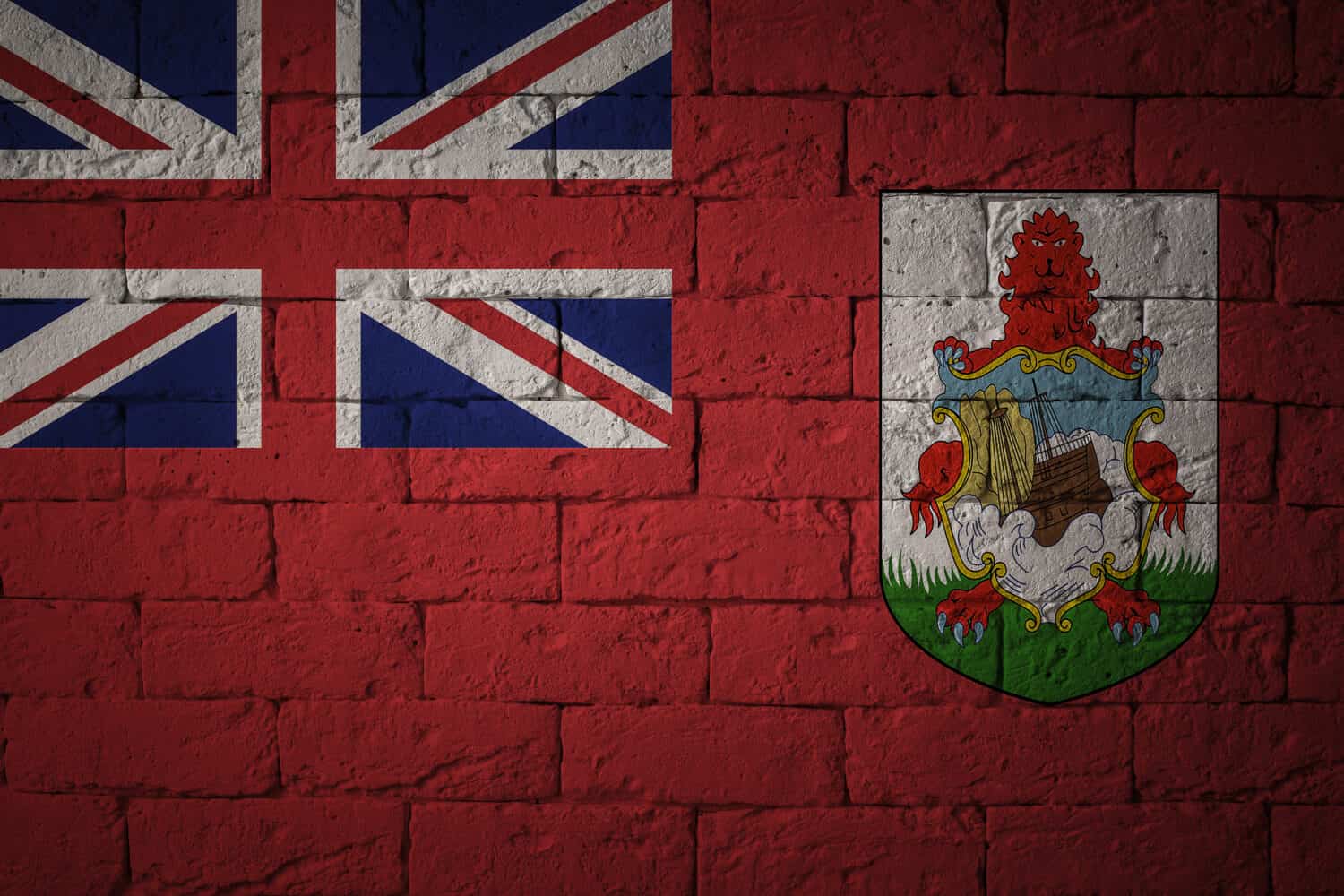
The flag of Bermuda is painted here on a wall.
©Greens and Blues/Shutterstock.com
The Union Jack is part of Bermuda’s flag, along with a coat of arms. The coat of arms depicts a red lion holding a shield with an illustration of a wrecked ship. The red lion is a symbol of England. The wrecked ship symbolizes the Sea Venture. The Sea Venture was a ship from the Virginia Company that was directed onto the reefs of Bermuda in 1609, to prevent it from being destroyed in the ocean by a powerful storm. The crew on the ship helped form the British colony that eventually became modern Bermuda. Underneath the shield is Latin text which reads “Quo Fata Ferunt,” meaning “Whither the Fates Carry Us.”
British Antarctic Territory, adopted in 1963

The British Antarctic Territory flag contains a Union Jack and a lion and penguin on the crest.
©zmotions/Shutterstock.com
The British Antarctic Territory flag is a Union Jack set against a white background, with a lion and a penguin added to the crest.
British Indian Ocean Territory, Adopted in 1990
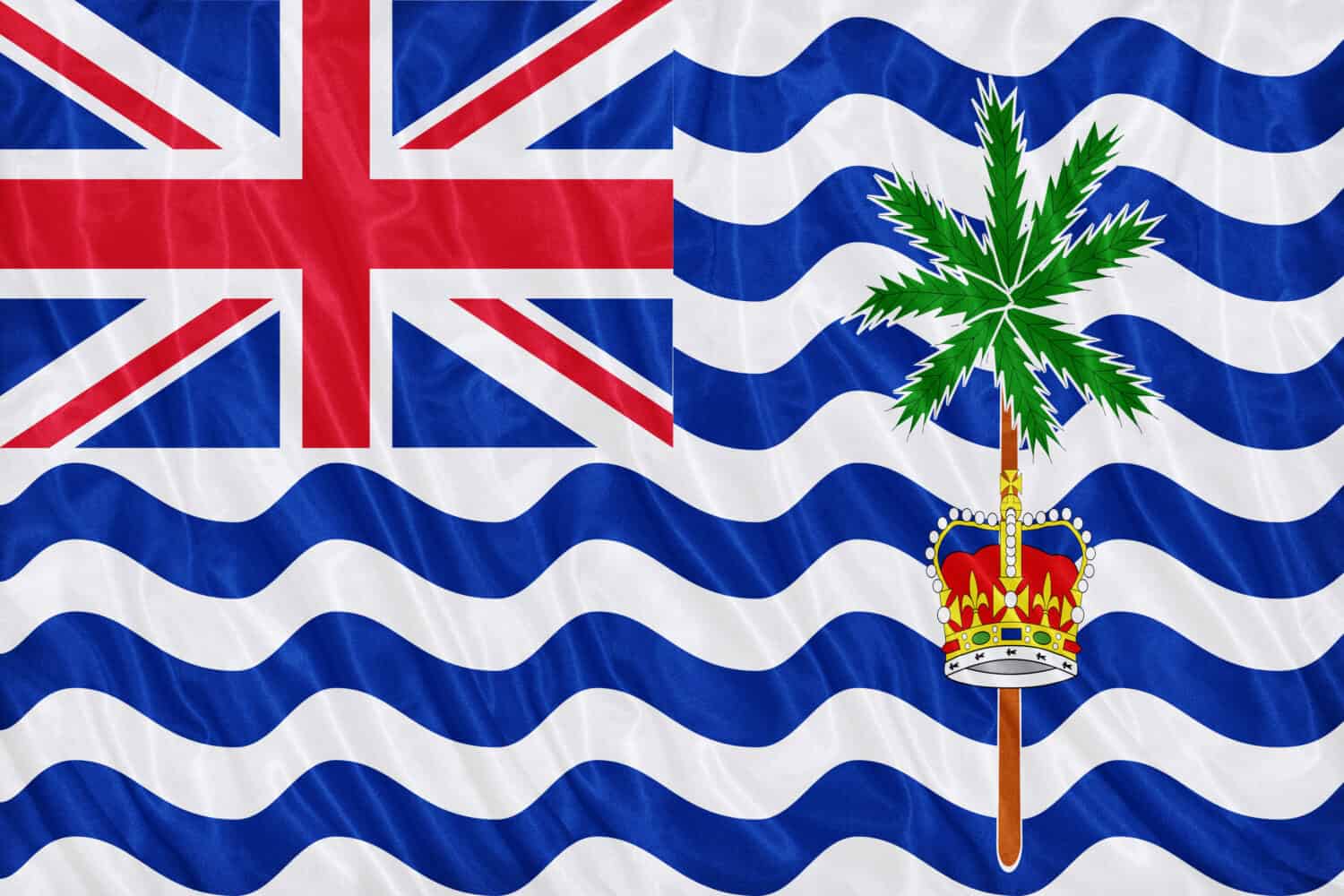
The British Indian Ocean Territory includes the Union Jack and wavy white and blue stripes representing water.
©Wasan Ritthawon/Shutterstock.com
One of the most unique flags is that of the British Indian Ocean Territory. This flag contains the Union Jack in its top-left corner. From there, wavy white and blue represent the waters of the Indian Ocean. Two symbols from the Coat of Arms of the British Indian Ocean Territory sit on the right: a palm tree and St. Edward’s Crown.
British Virgin Islands, Adopted in 1960
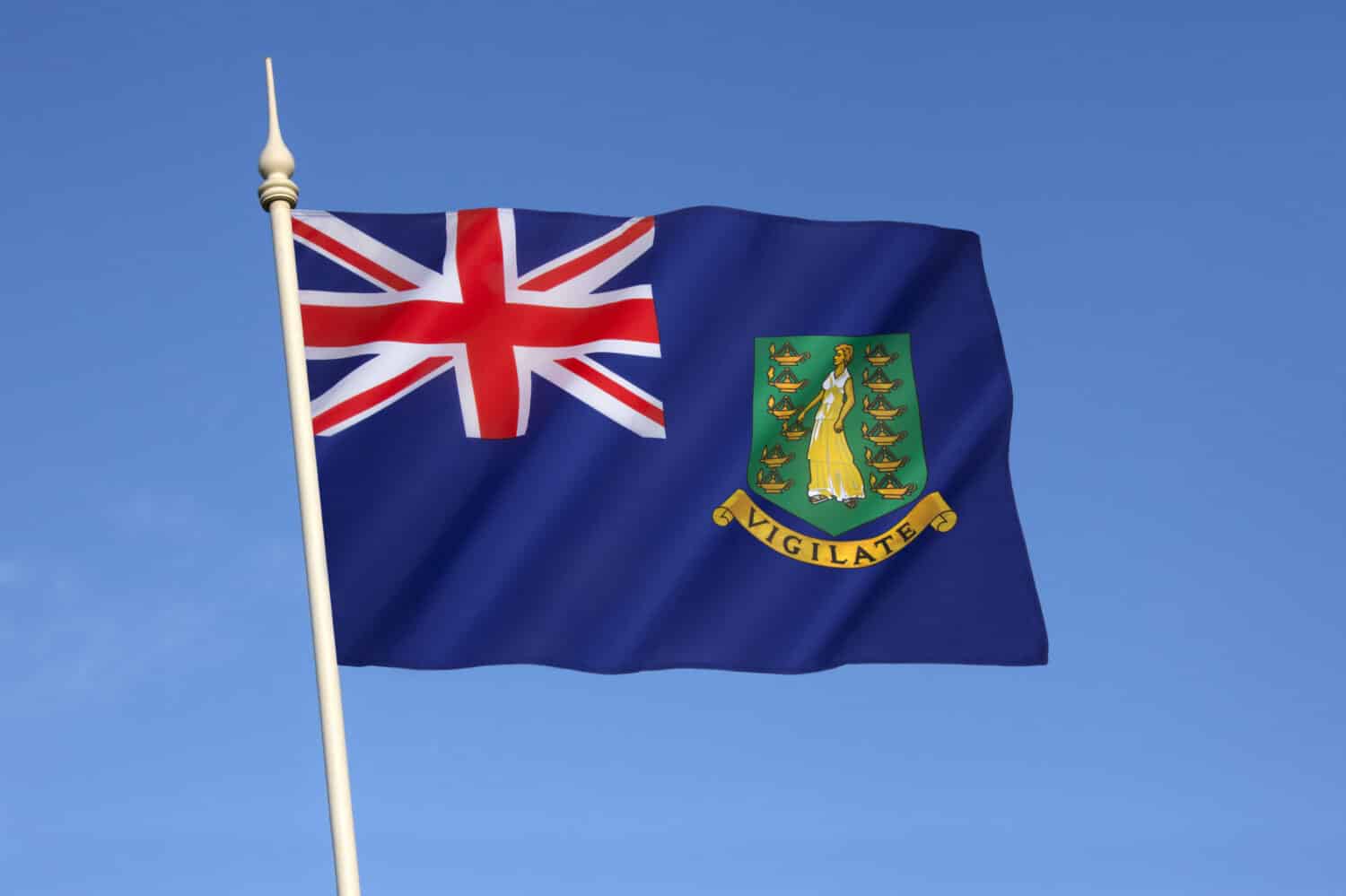
The flag of the British Virgin Islands has a green crest depicting St. Ursula with lamps of her followers.
©Steve Allen/Shutterstock.com
The flag of the British Virgin Islands includes the Union Jack in the top-left corner, with the blue ensign, and a coat of arms on the right. The Coat of Arms of the British Virgin Islands depicts St. Ursula against a green crest, holding lamps of her virgin followers, from which the islands gained their name. Underneath is the word “vigilate,” which means “to watch over.”
Cayman Islands, Adopted in 1958
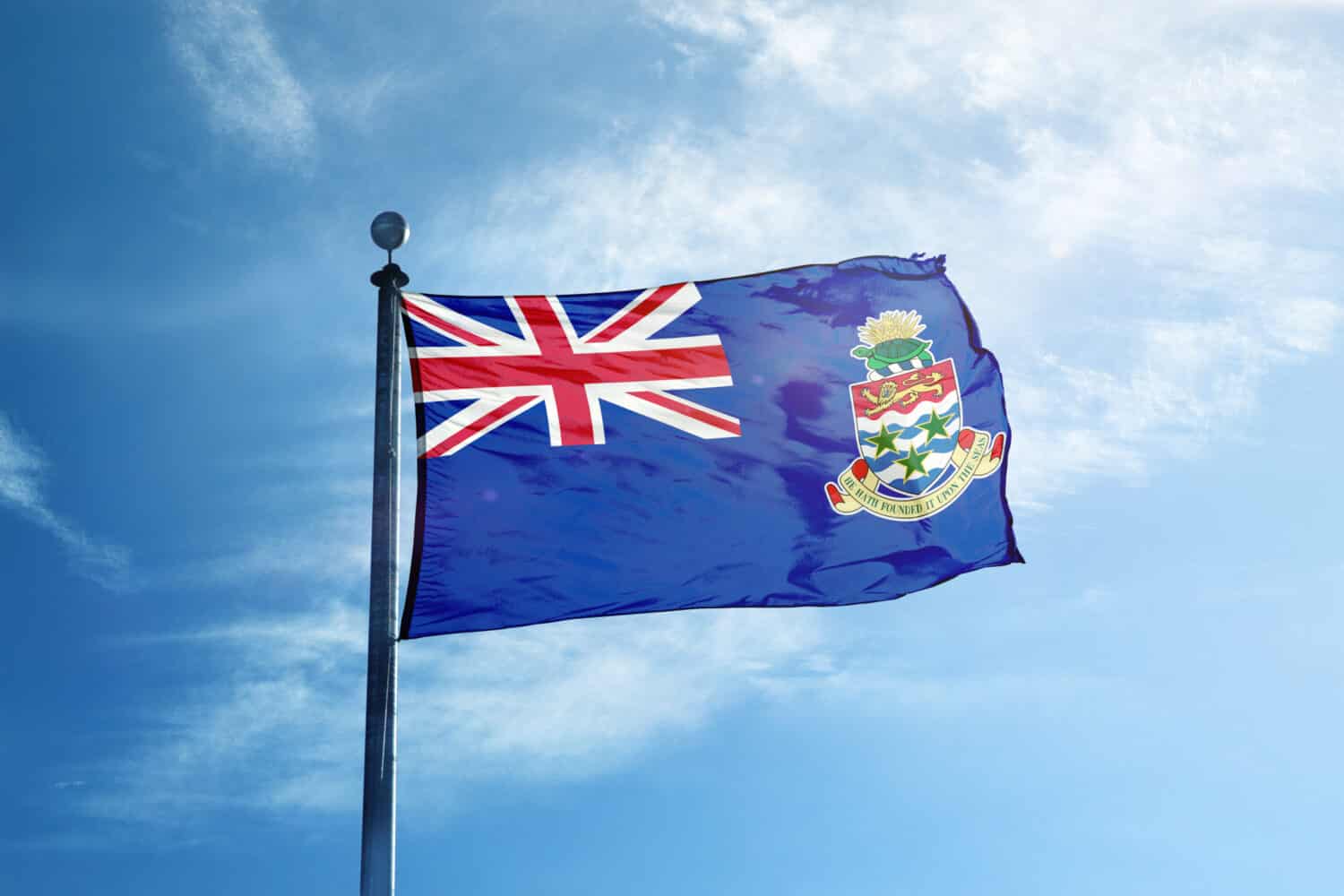
This is the flag of the Cayman Islands waving in the sky.
©Creative Photo Corner/Shutterstock.com
The flag of the Cayman Islands consists of a traditional Union Jack blue ensign with the territory’s coat of arms on the right. The Cayman Islands Coat of Arms features a British lion over stripes that represent the sea. There are also three green stars and a turtle. These represent the diverse wildlife found on the Cayman Islands.
Falkland Islands, adopted in 1999

The Falkland Islands flag includes a Union Jack next to the Falkland Islands’ coat of arms.
©iStock.com/DreamCursor
The Falkland Islands flag includes a Union Jack next to the Falkland Islands’ coat of arms. This includes a ram to represent the importance of the local sheep industry, as well as a ship – representing the Desire, a ship said to have been crewed by the European men who first came to the islands in the 16th century.
Montserrat, Adopted in 1962

The flag of Montserrat consists of a blue field with the Union Jack in the top-left quadrant, with a coat of arms on the right side of the flag.
©Greens and Blues/Shutterstock.com
Montserrat’s flag consists of a blue field with the Union Jack in the top-left quadrant, with a coat of arms on the right side of the flag. The coat of arms features a woman in a green dress, holding a yellow harp. This woman is Erin, the female personification of Ireland. She and the harp she holds represent Ireland and reflect the territory’s Irish ancestry. Blue represents awareness, trustworthiness, determination, and righteousness.
Pitcairn Islands, Adopted in 1984

The flag of the Pitcairn Islands consists of the Union Jack in the top-left quadrant, against a blue background with the coat of arms on the right.
©zmotions/Shutterstock.com
The flag of the Pitcairn Islands consists of the Union Jack in the top-left quadrant, against a blue background. To the right is the Pitcairn Islands’ Coat of Arms, which contains a depiction of the Bible and the anchor from the ship known as the Bounty. A green triangle represents the rugged cliffs of the island, while blue represents the sea. A wheelbarrow in the crest represents the first settlers, while a plant represents the wood the islanders use.
South Georgia and the South Sandwich Islands, Adopted in 1985

The flag of South Georgia and the South Sandwich Islands shows the Union Jack in the top-left corner, using the traditional blue ensign with the coat of arms to the right.
©zmotions/Shutterstock.com
The flag of South Georgia and the South Sandwich Islands shows the Union Jack in the top-left corner, using the traditional blue ensign with the coat of arms to the right. The coat of arms consists of a shield with a golden lion holding a torch, representing the United Kingdom and discovery. Two golden estoiles are from the arms of James Cook, who was an explorer of the islands. The shield is supported by an Antarctic fur seal on top of a mountain, and a macaroni penguin standing on ice. Both of these creatures live natively on the island. On the crest is a reindeer, representing the herds that live on the island of South Georgia.
Tristan da Cunha, Adopted in 2002

The flag of Tristan da Cunha includes the traditional blue ensign, of a Union Jack against a navy background. To the right is the official coat of arms.
©Millenius/Shutterstock.com
The flag of Tristan da Cunha was adopted in 2002 at the proclamation of the Governor of St. Helena. The flag’s design includes the traditional blue ensign, of a Union Jack against a navy background. To the right is the official coat of arms. The Coat of Arms of Tristan da Cunha consists of a longboat over a Naval Crown and a central shield adorned with four albatross flanked by two rock lobsters. Underneath is the territory’s motto, “Our faith is our strength.”
Turks and Caicos Islands, Adopted in 1968
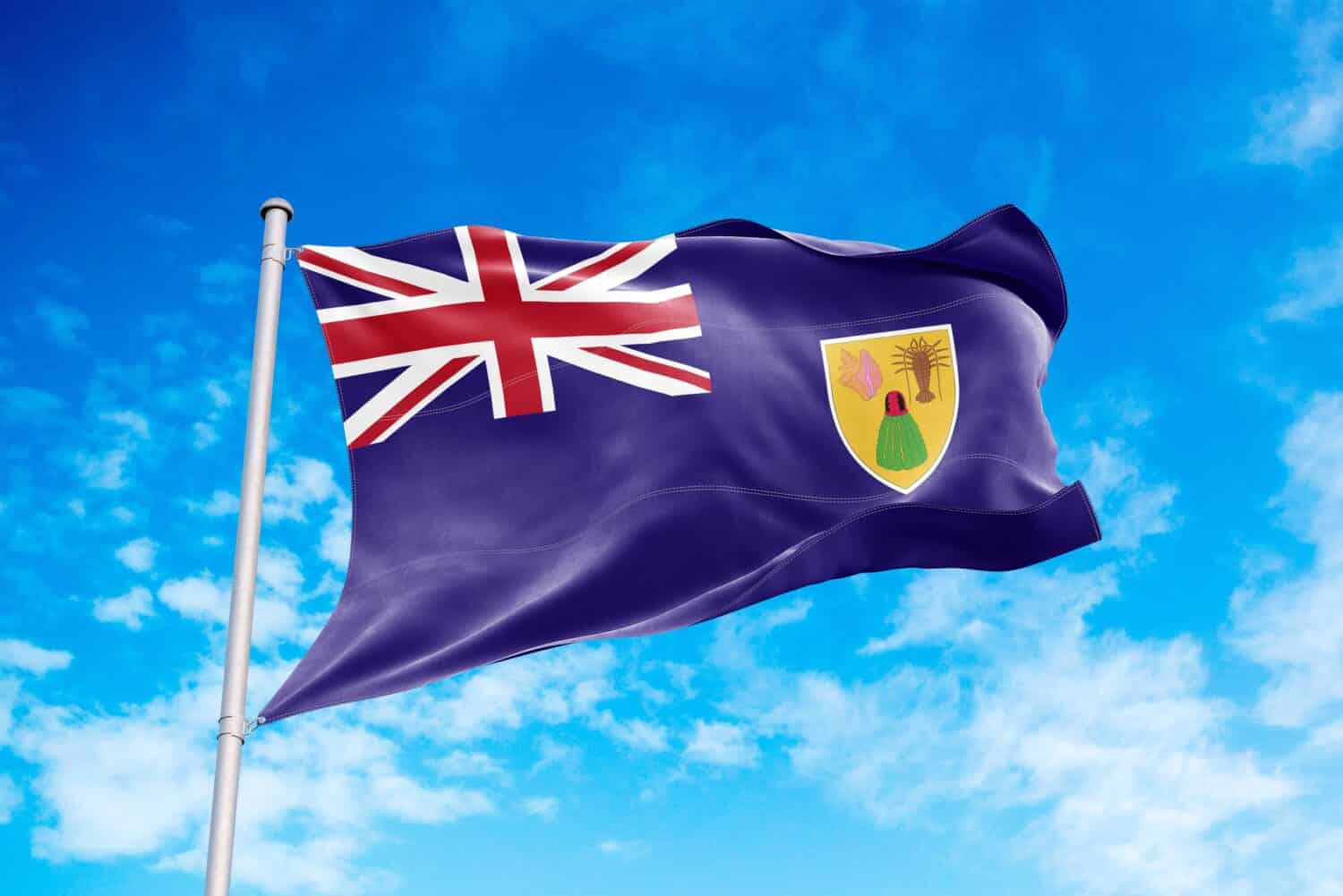
This is the Turks and Caicos Islands flag waving in the wind.
©zmotions/Shutterstock.com
The flag of the Turks and Caicos includes a blue field with the Union Jack in the left top corner and the territory’s coat of arms on the right, which features three symbols. First, the coat of arms includes a queen conch and spiny lobster, both of which are important food sources and have been for generations. Then the third symbol is the Turks Head cactus, a species of barrel cactus that is native to the Turks and Caicos, as well as other nearby Caribbean islands.
St. Helena, Adopted in 1984
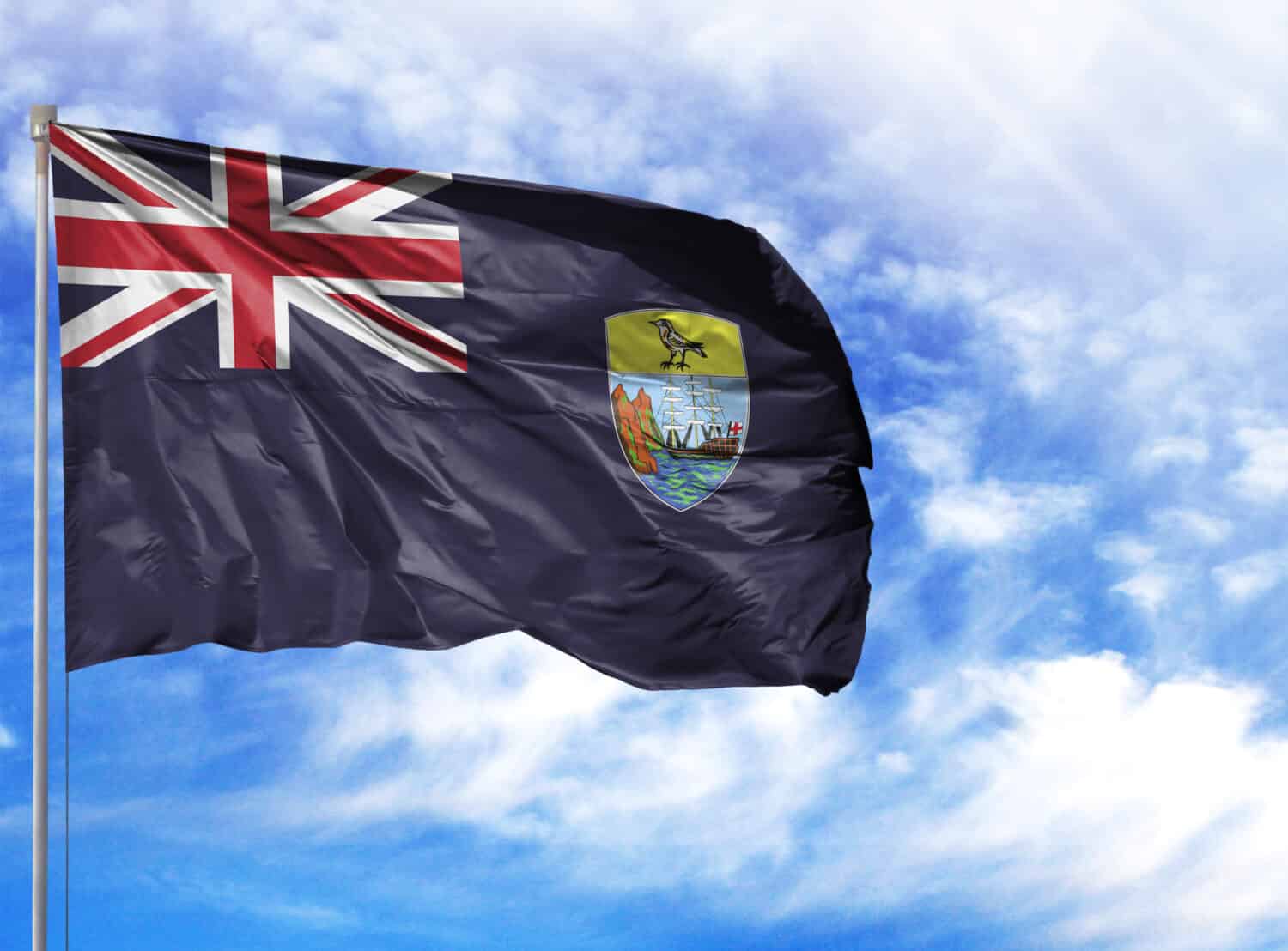
This is the flag of St. Helena.
©Millenius/Shutterstock.com
St. Helena’s flag was designed in 1983 to commemorate 150 years as a colony of the British Crown. In this flag, the Union Jack sits to the left of a crest. The crest depicts the national bird of Saint Helena, which is a wirebird, on a yellow background. Below it is a ship next to a rocky cliff.
Cook Islands, Adopted in 1979
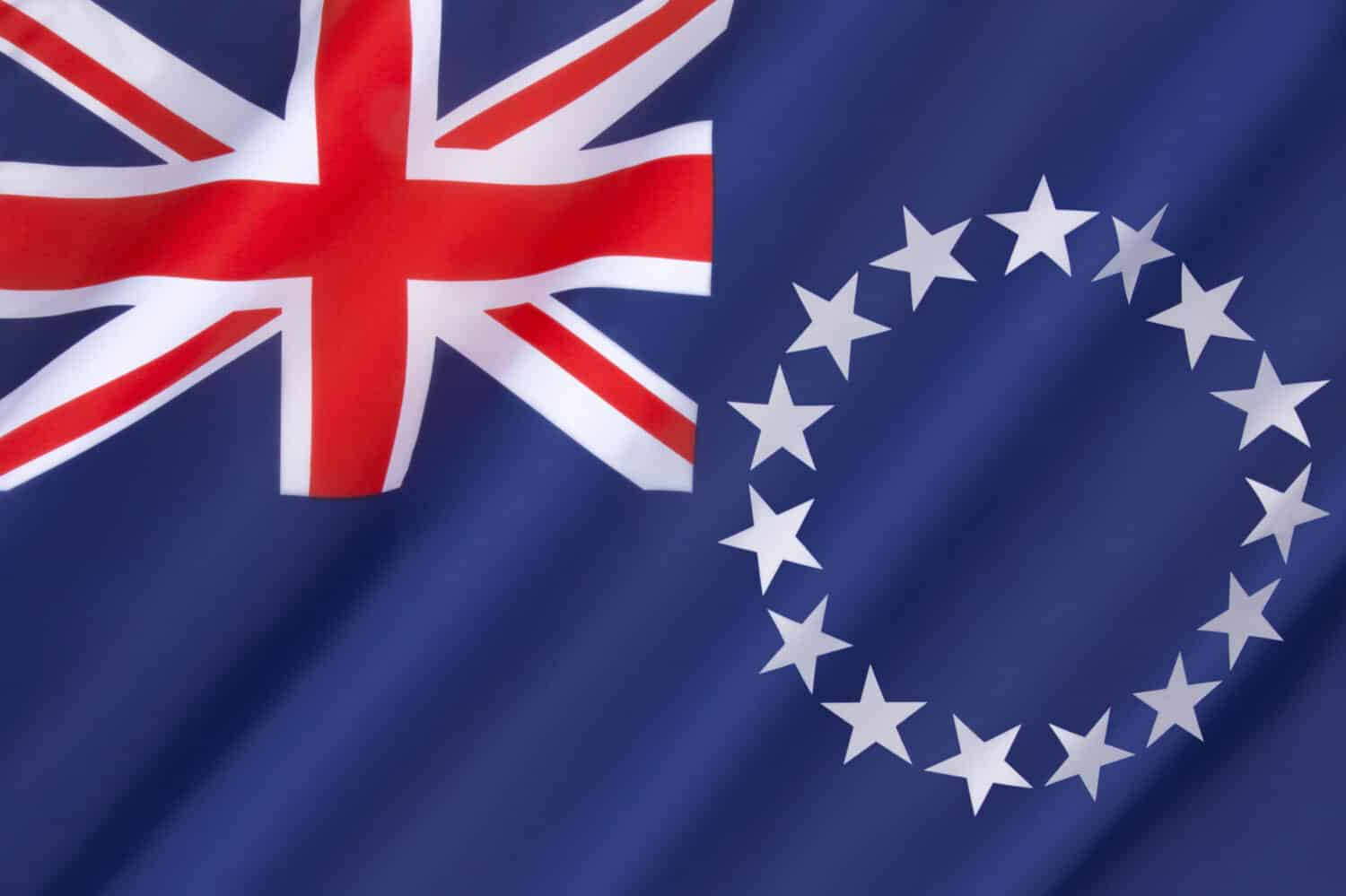
This is the flag of the Cook Islands.
©Steve Allen/Shutterstock.com
The Cook Islands are a self-governing territory of New Zealand. The Cook Islands’ flag includes the Union Jack against a dark blue background studded with a circle of white stars, which represent the main islands.
Niue, Adopted in 1975
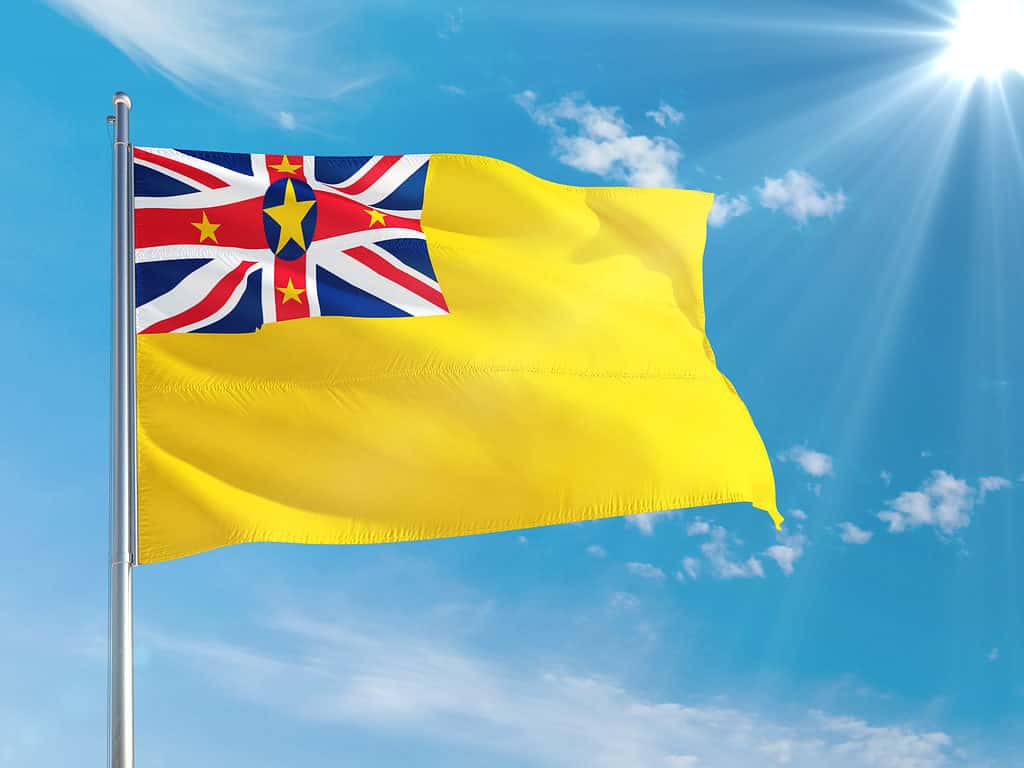
This is the flag of Niue.
©Black Pearl Footage/Shutterstock.com
The flag of Niue puts a unique spin on the Union Jack, positioning it against a vibrant yellow field. The Union Jack itself is studded with four yellow stars. Niue is associated with New Zealand, which is represented in the stars forming a diamond pattern depicting Southern Cross. The yellow field represents the bright sunshine of Niue and the warm feelings of the Niuean people toward New Zealand. The large star at the center of the Union Jack represents the island of Niue and its role in self-governance.
Ross Dependency, Adopted in 1975

The flag of Ross Dependency is a popular image on murals.
Image: vladm, Shutterstock
©vladm/Shutterstock.com
The Ross Dependency is a part of Antarctica. New Zealand claims jurisdiction over this part of the continent. Its flag consists of a Union Jack against a navy background, with four red and white-lined stars to the right.
States with Union Jacks in Their Flags
Hawaii, United States, adopted in 1845
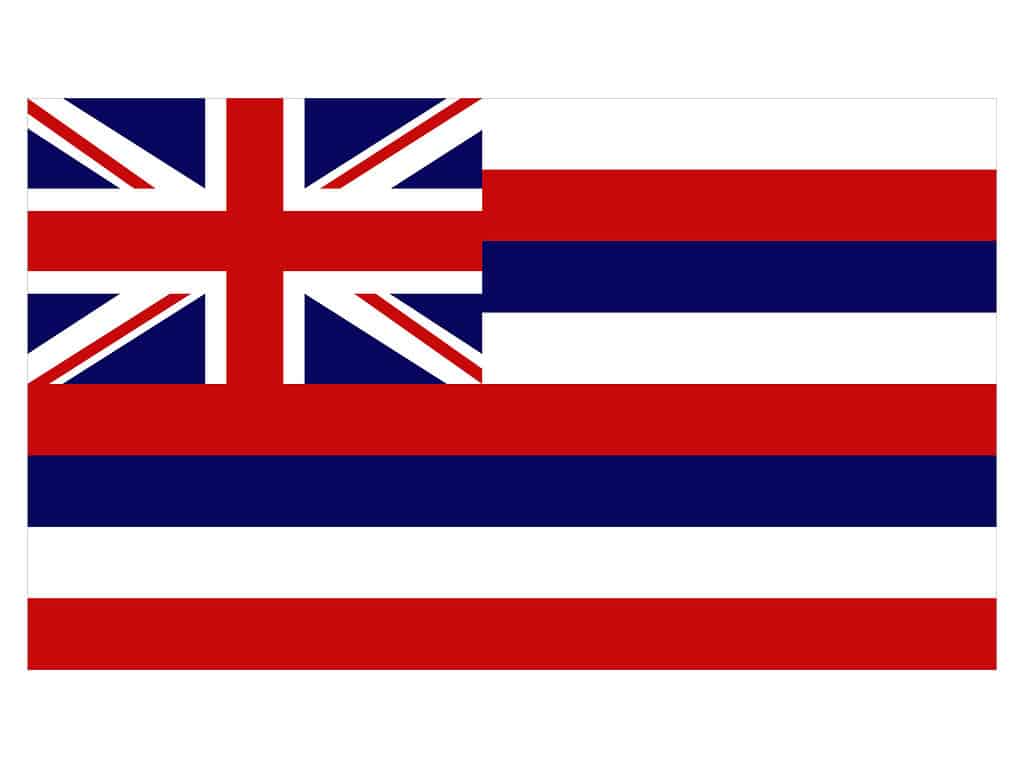
This is the official flag of the U.S. state of Hawaii.
©iStock.com/Milos Subasic
In 1959, Hawaii joined the United States as the 50th state and second outside of the continental U.S. Starting back in 1793, Hawaii’s flag was the Union Jack. This lasted until 1816. At that time, Hawaii redesigned the flag to include additional red, white, and blue stripes. Though Hawaii was never British, there was a significant relationship between the Hawaiian islands and the British Empire.
Summary of 23 Countries and Territories with Union Jack in Their Flags
| Country/Territory | Year Adopted | |
|---|---|---|
| 1 | United Kingdom | 1801 |
| 2 | Australia | 1908 |
| 3 | Fiji | 1970 |
| 4 | New Zealand | 1902 |
| 5 | Tuvalu | 1997 |
| 6 | Akrotiri and Dhekelia | 1978/1960 |
| 7 | Anguilla | 1990 |
| 8 | Ascension Island | 2013 |
| 9 | Bermuda | 1910 |
| 10 | British Antarctic Territory | 1963 |
| 11 | British Indian Ocean Territory | 1990 |
| 12 | British Virgin Islands | 1960 |
| 13 | Cayman Islands | 1958 |
| 14 | Falkland Islands | 1999 |
| 15 | Montserrat | 1962 |
| 16 | Pitcairn Islands | 1984 |
| 17 | South Georgia and the South Sandwich Islands | 1985 |
| 18 | Tristan da Cunha | 2002 |
| 19 | Turks and Caicos Islands | 1968 |
| 20 | St. Helena | 1984 |
| 21 | Cook Islands | 1979 |
| 22 | Niue | 1975 |
| 23 | Ross Dependency | 1975 |
| 24 | Hawaii (U.S. State) | 1845 |
The photo featured at the top of this post is © iStock.com/titoOnz
Thank you for reading! Have some feedback for us? Contact the AZ Animals editorial team.






